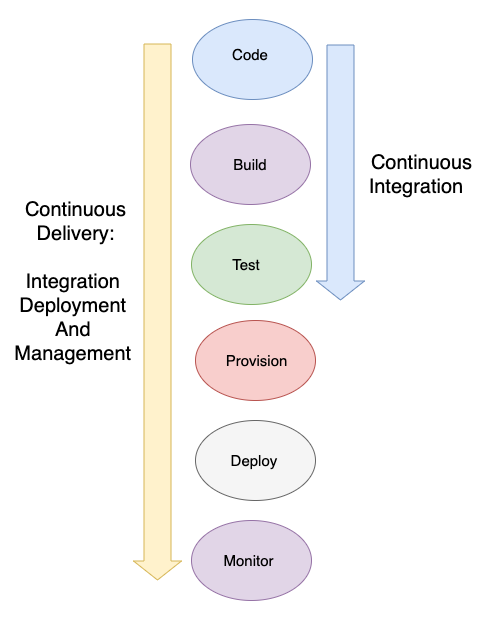In CI, developers commit code frequently to a code repository. The code is built frequently. Each build is tested using automated unit tests and integration tests. In CD, code changes are committed to the repository and developed frequently. Builds are deployed to test environments and are tested using automated, and possibly manual, tests. Successful builds pass tests and are deployed to staging or production environments. The following diagram illustrates the impact of CI versus CD in the software development life cycle:

As shown in the preceding diagram, CI refers to building and unit testing stages of the software development life cycle. Every update that is committed in the code repository creates an automated build and test. CD is an essential aspect of CI which extends CI process further to deploy build in production. In CI/CD practices, several people work on the code. They all must use the latest working build for their efforts. Code repositories maintain different versions of the code and also make the code accessible to the team. You check out the code from the repository, make your changes or write new code in your local copy, compile and test your code, and then frequently commit your code back to the repository.
CI automates most of the software release process. It creates an automated flow that builds, tests, and then stages the update. However, a developer must trigger the final deployment to a live production environment that is not automated. It expands upon CD by deploying all code changes to a testing environment and/or a production environment after the build stage. If CD is implemented correctly, developers will always have a tested and deployment-ready build.
The concepts in the following diagram illustrate everything related to the automation of an application, from code commits into a code repo, to the deployment pipeline. It shows an end-to-end flow, from build to the production environment where, developer check-in the code changes in code repository which is pulled by CI server. CI server trigger the build to create deployment package with new application binaries and corresponding dependencies. These new binaries are deployed in targeted development or testing environment. Also binaries get check-in into artifact repository for safe version controlled storage:

In CI/CD, software development life cycle phases such as code, build, deploy, and test are automated using the DevOps pipeline. The deploy and provision phase needs to be automated using IaC scripts. Monitoring can be automated with various monitoring tools.
A robust CD pipeline also automates the provisioning of infrastructure for testing and production environments and enables monitoring and management of test and production environments. CI/CD provides multiple benefits to the team, such as improving developer productivity by saving time on building, testing, and deployment of code. It helps the dev team to detect and fix bugs quickly and launch feature updates faster in the production environment.
CD does not mean that every change committed by the developer goes into production. Instead, it means that every change is ready to go into production. When the changes are staged and tested in the stage environment, a manual approval process initiates and gives a green signal to deploy to production. Thus, in CD, deploying to production becomes a business decision and is still automated with tools.
